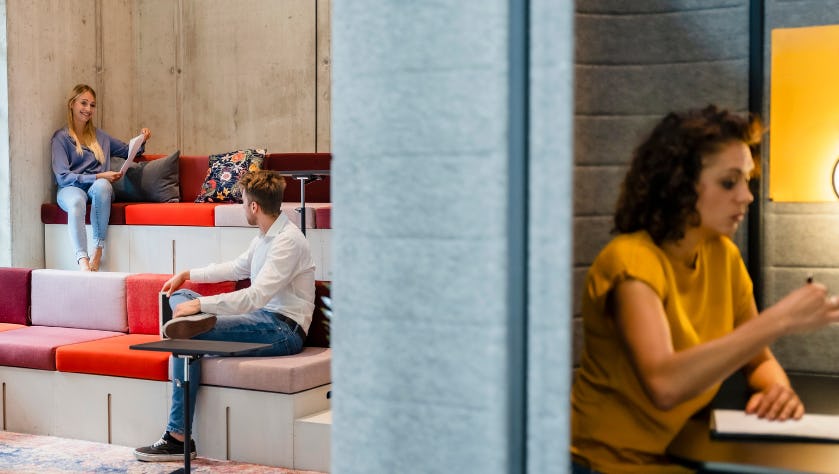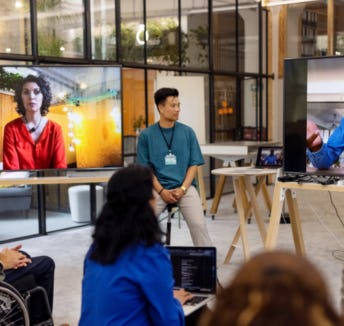
Creating an office that enhances wellbeing, creativity and collaboration is the essence of workplace design right now. Here’s how it was done in 2022.
Working from home, in your pyjamas with the dog by your side, still has a draw post-pandemic, so the office now has to work that bit harder. It’s got to give people positive experiences and it’s got to be adaptable, so it adds to people’s lives and fulfills its role in the modern hybrid system between home, flexspaces and the company HQ.
As 2022 draws to a close, we take a look at some of the most notable office trends…
Creating a journey
In McKinsey’s new Mumbai office, staff are taken on a journey. The movements they make from the revolving front doors to their desks, or their desks to the café, or wherever they are heading, are all considered and planned to create productive moments and heighten the creative juices. That’s partly because of the artworks on the walls (all created by local artists) or the various tones and styles of the different areas, or the planning – which departments occupy which space. But it all combines to enrich people’s experiences – something at the heart of 2022’s best work spaces.
Ishita Kayastha, associate partner in Mumbai, says she was slow to return to the office as the pandemic eased, but the “connectedness” of the McKinsey space, and the ability to pass by and chat with colleagues, has alleviated any hesitation. “It’s different than just running into someone in a hall or an elevator. The space encourages you to talk,” Ishita says. “I can feel the increase in energy and feeling of connectedness between teams.”
Neurodiversity
One word with so many modulations, neurodiversity, and a more nuanced understanding of it, is finally beginning to shape our working spaces. Whether that’s through the surface level design – the patterns on the carpets, for example, or the colours and contrast of the décor, to the way the spaces are used, or zoned – it is all a growing part of the design mindset.
Dutch travel company Booking.com is designing its new Amsterdam office to include “softer lighting schemes and quiet zones”, as well as calm spaces that are far removed from the hustle of the rest of the building. Clear signage, landmarks and “strategic use of colour” to help people navigate an office are all part of the process too, according to WorkDesign.com. Those long searches for meeting rooms with strange names or long numbers are so 2021.
Scalable spaces
Setting up an office can feel like a precarious balancing act. You want to have space to accommodate an increasing headcount and manage any fluctuations, without staff feeling like they’re invading their colleagues’ personal space. But you also can’t take on more than you need, and you can’t assume that all of your staff will be in at any point because you might have half of them working from home or a satellite office closer to them, especially on Fridays and Mondays.
This is where scalable flexspaces come in. At our Spaces offices we use booths, benches, and agile areas that enable you to use the space you need on that day – it’s not limited. That’s as well as the private offices for when you need to get your head down, and the cafe areas for one- to-ones or client meetings. Our implementation service means that our offices are both bespoke and flexible – they work.
Video conferencing monitors
Of all the tech that’s had to move at hyper speed in recent years, video conferencing is probably the big one. It’s provided a lot of laughs (strange closeups, sensors homing in on the fruit bowl rather than your colleague’s face) but when it works, it really works. In the age of hybrid, a seamless video conferencing model is paramount. It connects people and offices wherever they are, allowing you to take a global view on clients and staff, and at its most simple, just get the work done.
Allying good software with clever assembly of hardware like monitors is a growing office trend, with each remote attendee having a dedicated screen in the meeting room at head height, enabling them to take part in the discussion as if they were actually in the room.
Sometimes it’s about the physical space and set up of a room, other times it’s about the tech giving you access to natural-feeling conferences. The metaverse, for example, will offer a solution where “you can feel like you’re in close proximity to people even though you’re all working in different places,” says Sammy King, from Meta.
Data driven designs
When so many of our behaviours are measured in data and analytics, (exercise, sleep, footsteps – all of the above if you have a smartwatch) it makes sense that office design is based on the same type of metrics. By analysing employees’ movements and how they use an office, it’s possible to improve the design, energy efficiency, and day to day experiences within it.
Desk usage, meeting room bookings, even logging staff in and out of the building to measure the busiest in-office days can all help to direct decisions about space and the location too. Like so many of this year’s trends, it is people focussed, driven by all of the things that we missed in lockdown when we weren’t allowed in the office. Because it was missed. Work needs collaboration, and people, and a degree of informality that great workspaces can foster.
If you want a flexible, thoughtfully-designed workspace for you or your team, explore our flex workspace solutions today.
Share this article
 Read now Ssshh, I’m not really here: How to combat ‘quiet quitting’
Read now Ssshh, I’m not really here: How to combat ‘quiet quitting’
 Read now How to nail your meetings in the hybrid world
Read now How to nail your meetings in the hybrid world